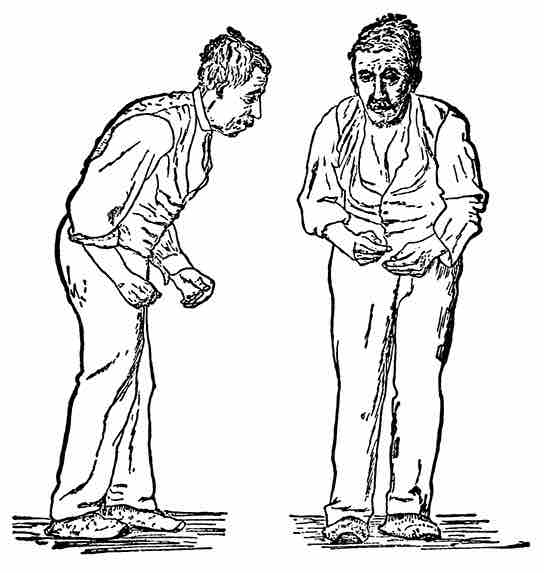Neurodegenerative Disorders
Neurodegenerative disorders are illnesses characterized by a loss of nervous system functioning that are usually caused by neuronal death. These diseases generally worsen over time as more and more neurons die. The symptoms of a particular neurodegenerative disease are related to where in the nervous system the death of neurons occurs. Spinocerebellar ataxia, for example, leads to neuronal death in the cerebellum. The death of these neurons causes problems in balance and walking. Neurodegenerative disorders include Huntington's disease, amyotrophic lateral sclerosis (ALS), Alzheimer's disease, other dementia disorders, and Parkinson's disease. In this section, Alzheimer's and Parkinson's disease will be discussed in more depth.
Alzheimer's Disease
Alzheimer's disease is the most common cause of dementia in the elderly. In 2012, an estimated 5.4 million Americans suffered from Alzheimer's disease. Payments for their care are estimated at $200 billion. Roughly one in every eight people age 65 or older has the disease. Due to the aging of the baby-boomer generation, there are projected to be as many as 13 million Alzheimer's patients in the United States in the year 2050.
Symptoms of Alzheimer's disease include disruptive memory loss, confusion about time or place, difficulty planning or executing tasks, poor judgement, and personality changes. Problems smelling certain scents can also be indicative of Alzheimer's disease and may serve as an early warning sign. Many of these symptoms are also common in people who are aging normally, so it is the severity and longevity of the symptoms that determine whether a person is suffering from Alzheimer's.
Alzheimer's disease was named for Alois Alzheimer, a German psychiatrist who published a report in 1911 about a woman who showed severe dementia symptoms. Along with his colleagues, he examined the woman's brain following her death and reported the presence of abnormal clumps, which are now called amyloid plaques, along with tangled brain fibers called neurofibrillary tangles. Amyloid plaques, neurofibrillary tangles, and an overall shrinking of brain volume are commonly seen in the brains of Alzheimer's patients. Loss of neurons in the hippocampus is especially severe in advanced Alzheimer's patients . Many research groups are examining the causes of these hallmarks of the disease.

Alzheimer's disease
Compared to a normal brain (left), the brain from a patient with Alzheimer's disease (right) shows a dramatic neurodegeneration, particularly within the ventricles and hippocampus.
One form of the disease is usually caused by mutations in one of three known genes. This rare form of early-onset Alzheimer's disease affects fewer than five percent of patients with the disease and causes dementia beginning between the ages of 30 and 60. The more prevalent, late-onset form of the disease probably also has a genetic component. One particular gene, apolipoprotein E (APOE) has a variant (E4) that increases a carrier's probability of developing the disease. Many other genes have been identified that may be involved in the pathology.
Unfortunately, there is no cure for Alzheimer's disease. Current treatments focus on managing the symptoms of the disease. Because decrease in the activity of cholinergic neurons (neurons that use the neurotransmitter acetylcholine) is common in Alzheimer's disease, several drugs used to treat the disease work by increasing acetylcholine neurotransmission, often by inhibiting the enzyme that breaks down acetylcholine in the synaptic cleft. Other clinical interventions focus on behavioral therapies such as psychotherapy, sensory therapy, and cognitive exercises. Since Alzheimer's disease appears to hijack the normal aging process, research into prevention is prevalent.
Parkinson's Disease
Parkinson's disease is also a neurodegenerative disease. It was first characterized by James Parkinson in 1817. Each year, 50,000-60,000 people in the United States are diagnosed with the disease. Parkinson's disease causes the loss of dopamine neurons in the substantia nigra, a midbrain structure that regulates movement. Loss of these neurons causes many symptoms including tremor (shaking of fingers or a limb), slowed movement, speech changes, balance and posture problems, and rigid muscles. The combination of these symptoms often causes a characteristic slow, hunched, shuffling walk. Patients with Parkinson's disease can also exhibit psychological symptoms, such as dementia or emotional problems.
Although some patients have a form of the disease known to be caused by a single mutation, for most patients, the exact causes of Parkinson's disease remain unknown. The disease probably results from a combination of genetic and environmental factors, similar to Alzheimer's disease . Post-mortem analysis of brains from Parkinson's patients shows the presence of Lewy bodies, abnormal protein clumps, in dopaminergic neurons. The prevalence of these Lewy bodies often correlates with the severity of the disease.

Parkinson's disease
Parkinson's patients often have a characteristic hunched walk. The disease is likely the result of a combination of genetic and environmental factors.
There is no cure for Parkinson's disease; treatment is focused on easing symptoms. One of the most-commonly prescribed drugs for Parkinson's is L-DOPA, which is a chemical that is converted into dopamine by neurons in the brain. This conversion increases the overall level of dopamine neurotransmission and can help compensate for the loss of dopaminergic neurons in the substantia nigra. Other drugs work by inhibiting the enzyme that breaks down dopamine.